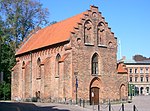Stadsparken, Lund
LundParks in SwedenTourist attractions in Lund

Stadsparken (Swedish for City's park) is a park located in central Lund. It is located within the historic Lund city area in Lund municipality in Skåne. The park celebrated its 100th anniversary in 2011. Stadsparken houses several sculptures by Gunnar Nordborg and Egon Möller-Nielsen, among others, as well as a small garden maze designed by Oscar Reutersvärd.
Excerpt from the Wikipedia article Stadsparken, Lund (License: CC BY-SA 3.0, Authors, Images).Stadsparken, Lund
Högevall, Lund
Geographical coordinates (GPS) Address Nearby Places Show on map
Geographical coordinates (GPS)
| Latitude | Longitude |
|---|---|
| N 55.699091666667 ° | E 13.185525 ° |
Address
Högevall
222 29 Lund (Centrum)
Sweden
Open on Google Maps











